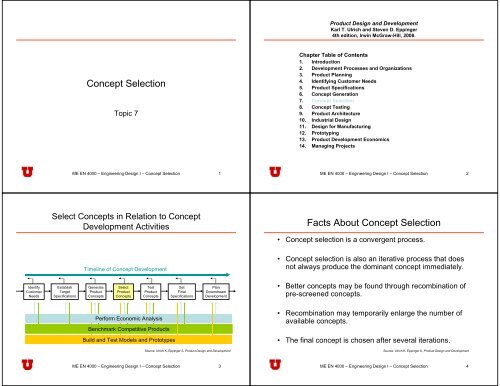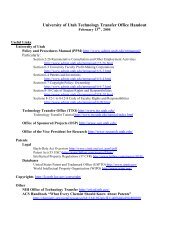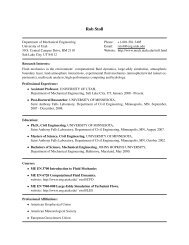Concept Selection Facts About Concept Selection
Concept Selection Facts About Concept Selection
Concept Selection Facts About Concept Selection
You also want an ePaper? Increase the reach of your titles
YUMPU automatically turns print PDFs into web optimized ePapers that Google loves.
Identify<br />
Customer<br />
Needs<br />
<strong>Concept</strong> <strong>Selection</strong><br />
Topic 7<br />
ME EN 4000 – Engineering Design I – <strong>Concept</strong> <strong>Selection</strong> 1<br />
Select <strong>Concept</strong>s in Relation to <strong>Concept</strong><br />
Development Activities<br />
Establish<br />
Target<br />
Specifications<br />
Timeline of <strong>Concept</strong> Development<br />
Generate<br />
Product<br />
<strong>Concept</strong>s<br />
Select<br />
Product<br />
<strong>Concept</strong>s<br />
Test<br />
Product<br />
<strong>Concept</strong>s<br />
Perform Economic Analysis<br />
Benchmark Competitive Products<br />
Build and Test Models and Prototypes<br />
Set<br />
Final<br />
Specifications<br />
Plan<br />
Downstream<br />
Development<br />
Source: Ulrich K, Eppinger S, Product Design and Development<br />
ME EN 4000 – Engineering Design I – <strong>Concept</strong> <strong>Selection</strong> 3<br />
Product Design and Development<br />
Karl T. Ulrich and Steven D. Eppinger<br />
4th edition, Irwin McGraw-Hill, 2008.<br />
Chapter Table of Contents<br />
1. Introduction<br />
2. Development Processes and Organizations<br />
3. Product Planning<br />
4. Identifying Customer Needs<br />
5. Product Specifications<br />
6. <strong>Concept</strong> Generation<br />
7. <strong>Concept</strong> <strong>Selection</strong><br />
8. <strong>Concept</strong> Testing<br />
9. Product Architecture<br />
10. Industrial Design<br />
11. Design for Manufacturing<br />
12. Prototyping<br />
13. Product Development Economics<br />
14. Managing Projects<br />
ME EN 4000 – Engineering Design I – <strong>Concept</strong> <strong>Selection</strong> 2<br />
<strong>Facts</strong> <strong>About</strong> <strong>Concept</strong> <strong>Selection</strong><br />
• <strong>Concept</strong> selection is a convergent process.<br />
• <strong>Concept</strong> selection is also an iterative process that does<br />
not always produce the dominant concept immediately.<br />
• Better concepts may be found through recombination of<br />
pre-screened concepts.<br />
• Recombination may temporarily enlarge the number of<br />
available concepts.<br />
• The final concept is chosen after several iterations.<br />
Source: Ulrich K, Eppinger S, Product Design and Development<br />
ME EN 4000 – Engineering Design I – <strong>Concept</strong> <strong>Selection</strong> 4
<strong>Concept</strong> Development Funnel<br />
concept generation<br />
concept screening<br />
concept scoring<br />
concept testing<br />
ME EN 4000 – Engineering Design I – <strong>Concept</strong> <strong>Selection</strong> 5<br />
<strong>Selection</strong> Methods (contd.)<br />
• Multivoting. Each member of the team votes for a set<br />
number of projects.<br />
– Maybe: Depends on how objectively the team members vote..<br />
• Pros and cons. The team lists strengths and<br />
weaknesses of each concept and makes a choice based<br />
upon group opinion.<br />
– Yes: The decision is group based and (presumably) objective.<br />
• Prototype and test. The organization builds and tests<br />
prototypes of each concept, making a selection based<br />
upon test data.<br />
– No: Too costly for hundreds of concepts.<br />
– Yes: Final concept selection.<br />
Source: Ulrich K, Eppinger S, Product Design and Development<br />
ME EN 4000 – Engineering Design I – <strong>Concept</strong> <strong>Selection</strong> 7<br />
<strong>Selection</strong> Methods<br />
• External decision. <strong>Concept</strong>s are turned over to the<br />
customer or other external entity.<br />
– No: Customer should not be bothered with hundreds of<br />
concepts.<br />
– Maybe: Final concept selection.<br />
• Product champion. An influential member of the<br />
product development team chooses a concept based on<br />
personal preference.<br />
– No: Group consensus is preferable both for confidence and<br />
harmony.<br />
• Intuition. The concept is chosen by its feel. No explicit<br />
criteria are used. The concept simply seems better.<br />
– No: Design decisions need to be objective and justifiable.<br />
Source: Ulrich K, Eppinger S, Product Design and Development<br />
ME EN 4000 – Engineering Design I – <strong>Concept</strong> <strong>Selection</strong> 6<br />
<strong>Selection</strong> Methods (contd.)<br />
• Decision matrices. The team rates each concept<br />
against pre-specified selection criteria, which may be<br />
weighted.<br />
– Yes: Preferred method.<br />
Source: Ulrich K, Eppinger S, Product Design and Development<br />
ME EN 4000 – Engineering Design I – <strong>Concept</strong> <strong>Selection</strong> 8
Two Stage Process<br />
1. <strong>Concept</strong> Screening<br />
– Quick, approximate evaluation aimed at<br />
producing a small number of viable<br />
solutions.<br />
2. <strong>Concept</strong> Scoring<br />
– Much more careful analysis of a relative<br />
small number of concepts in order to choose<br />
the single best option.<br />
Source: Ulrich K, Eppinger S, Product Design and Development<br />
ME EN 4000 – Engineering Design I – <strong>Concept</strong> <strong>Selection</strong> 9<br />
<strong>Concept</strong> Screening: Steps 4-6<br />
• Step 4 – Combine and Improve <strong>Concept</strong>s.<br />
– Is there a generally good concept which is degraded by a single<br />
bad feature?<br />
– Are there two concepts which can be combined to preserve the<br />
“better than” qualities while canceling the “worse than” features?<br />
• Step 5 – Select One or More <strong>Concept</strong>s.<br />
– After the team has gained sufficient understanding of each<br />
concept and its relative quality, a small number of concepts are<br />
chosen for further analysis and refinement (and perhaps testing).<br />
• Step 6 – Reflect on the Results and Process.<br />
– All team members should be comfortable with the outcome.<br />
Differences between team members may indicate missing<br />
criteria or rating errors.<br />
Source: Ulrich K, Eppinger S, Product Design and Development<br />
ME EN 4000 – Engineering Design I – <strong>Concept</strong> <strong>Selection</strong> 11<br />
<strong>Concept</strong> Screening: Steps 1-3<br />
• Step 1 – Prepare the <strong>Selection</strong> Matrix.<br />
– Enter concepts and criteria into the matrix.<br />
– Select reference concept (industry standard, main competitor,<br />
current product). Its performance is rated using 0’s.<br />
• Step 2 – Rate the <strong>Concept</strong>s.<br />
– <strong>Concept</strong>s that perform better than the reference are rated with +’s.<br />
– <strong>Concept</strong>s that perform similarly compared to the reference are<br />
rated with 0’s.<br />
– <strong>Concept</strong>s that perform worse than the reference are rated with –’s.<br />
• Step 3 – Rank the <strong>Concept</strong>s.<br />
– Sum up “better than”, “same as”, and “worse than” and enter the<br />
sum for each category in the lower rows of the matrix.<br />
– The net score is calculated by subtracting the number of “worse<br />
than” from the number of “better than”.<br />
Source: Ulrich K, Eppinger S, Product Design and Development<br />
ME EN 4000 – Engineering Design I – <strong>Concept</strong> <strong>Selection</strong> 10<br />
Outpatient Syringe<br />
<strong>Concept</strong> A – Master Cylinder<br />
Each concept should include a sketch and short description<br />
All concepts should include a similar level of detail<br />
Displaced fluid from master cylinder actuates pusher. Upon release, sealed<br />
fluid cavity is filled with more fluid if necessary.<br />
Dose is set by length of stroke.<br />
Source: Ulrich K, Eppinger S, Product Design and Development<br />
ME EN 4000 – Engineering Design I – <strong>Concept</strong> <strong>Selection</strong> 12
Outpatient Syringe<br />
<strong>Concept</strong> B – Rubber Brake<br />
Pushnut grips shaft when pushed but releases when being pulled (rubber<br />
clutch offers resistance).<br />
Dose is set by length of stroke.<br />
Source: Ulrich K, Eppinger S, Product Design and Development<br />
ME EN 4000 – Engineering Design I – <strong>Concept</strong> <strong>Selection</strong> 13<br />
Outpatient Syringe<br />
<strong>Concept</strong> D – Plunge Stop (Reference)<br />
Stroke length is set by screwing outer sleeve forward, thereby increasing the<br />
spacing between plunger and outer sleeve<br />
Source: Ulrich K, Eppinger S, Product Design and Development<br />
ME EN 4000 – Engineering Design I – <strong>Concept</strong> <strong>Selection</strong> 15<br />
Outpatient Syringe<br />
<strong>Concept</strong> C - Ratchet<br />
Ratchet engages pusher when plunger is being pushed and disengaged is<br />
plunger is being pulled.<br />
Dose is set by length of stroke.<br />
Source: Ulrich K, Eppinger S, Product Design and Development<br />
ME EN 4000 – Engineering Design I – <strong>Concept</strong> <strong>Selection</strong> 14<br />
Outpatient Syringe<br />
<strong>Concept</strong> F<br />
Stroke length is set through angle of operating lever.<br />
Source: Ulrich K, Eppinger S, Product Design and Development<br />
ME EN 4000 – Engineering Design I – <strong>Concept</strong> <strong>Selection</strong> 16
Outpatient Syringe<br />
<strong>Concept</strong> G – Dial Screw<br />
Set dose by turning knob. This energy is stored in a spring.<br />
Actuate by releasing the lead screw, which will turn according to the<br />
rotational energy supplied by the spring.<br />
Source: Ulrich K, Eppinger S, Product Design and Development<br />
ME EN 4000 – Engineering Design I – <strong>Concept</strong> <strong>Selection</strong> 17<br />
<strong>Concept</strong> generation<br />
Pair-up with a team mate<br />
In upper right of your page<br />
•Names of students<br />
•Project Name<br />
•TA Name<br />
• List some criteria that you might judge your<br />
designs on<br />
CONCEPT VARIANTS<br />
SELECTION<br />
CRITERIA<br />
A B C D E F G REF.<br />
Ease of Handling 0 0 – 0 0 – – 0<br />
Ease of Use 0 – – 0 0 + 0 0<br />
Number Readability 0 0 + 0 + 0 + 0<br />
Dose Metering + + + + + 0 + 0<br />
Load Handling 0 0 0 0 0 + 0 0<br />
Manufacturing Ease + – – 0 0 – 0 0<br />
Portability + + – – 0 – – 0<br />
PLUSES 3 2 2 1 2 2 2<br />
SAMES 4 3 1 5 5 2 3<br />
MINUSES 0 2 4 1 0 3 2<br />
NET 3 0 –2 0 2 –1 0<br />
RANK 1 3 7 5 2 6 4<br />
CONTINUE? Yes Yes No No Yes No Yes<br />
ME EN 4000 – Engineering Design I – <strong>Concept</strong> <strong>Selection</strong> 19<br />
Example: <strong>Concept</strong> Screening<br />
CONCEPT VARIANTS<br />
SELECTION<br />
CRITERIA<br />
A B C D E F G REF.<br />
Ease of Handling 0 0 – 0 0 – – 0<br />
Ease of Use 0 – – 0 0 + 0 0<br />
Number Readability 0 0 + 0 + 0 + 0<br />
Dose Metering + + + + + 0 + 0<br />
Load Handling 0 0 0 0 0 + 0 0<br />
Manufacturing Ease + – – 0 0 – 0 0<br />
Portability + + – – 0 – – 0<br />
PLUSES 3 2 2 1 2 2 2<br />
SAMES 4 3 1 5 5 2 3<br />
MINUSES 0 2 4 1 0 3 2<br />
NET 3 0 –2 0 2 –1 0<br />
RANK 1 3 7 5 2 6 4<br />
CONTINUE? Yes Yes No No Yes No Yes<br />
ME EN 4000 – Engineering Design I – <strong>Concept</strong> <strong>Selection</strong> 18<br />
Outpatient Syringe<br />
<strong>Concept</strong> DF<br />
Source: Ulrich K, Eppinger S, Product Design and Development<br />
ME EN 4000 – Engineering Design I – <strong>Concept</strong> <strong>Selection</strong> 20
Outpatient Syringe<br />
<strong>Concept</strong> G+<br />
Source: Ulrich K, Eppinger S, Product Design and Development<br />
ME EN 4000 – Engineering Design I – <strong>Concept</strong> <strong>Selection</strong> 21<br />
Example: <strong>Concept</strong> Scoring<br />
<strong>Concept</strong>s<br />
A<br />
(reference)<br />
DF E G+<br />
Master Cylinder Lever Stop Swash Ring Dial Screw+<br />
Weighted<br />
Weighted<br />
Weighted<br />
Weighted<br />
<strong>Selection</strong> Criteria Weight Rating Score Rating Score Rating Score Rating Score<br />
Ease of Handling 5% 3 0.15 3 0.15 4 0.2 4 0.2<br />
Ease of Use 15% 3 0.45 4 0.6 4 0.6 3 0.45<br />
Readability of Settings 10% 2 0.2 3 0.3 5 0.5 5 0.5<br />
Dose Metering Accuracy 25% 3 0.75 3 0.75 2 0.5 3 0.75<br />
Durability 15% 2 0.3 5 0.75 4 0.6 3 0.45<br />
Ease of Manufacture 20% 3 0.6 3 0.6 2 0.4 2 0.4<br />
Portability 10% 3 0.3 3 0.3 3 0.3 3 0.3<br />
Total Score 2.75<br />
3.45<br />
3.10<br />
3.05<br />
Rank<br />
4<br />
1<br />
2<br />
3<br />
Continue? No Develop No No<br />
ME EN 4000 – Engineering Design I – <strong>Concept</strong> <strong>Selection</strong> 23<br />
<strong>Concept</strong> Scoring<br />
• Similar to concept screening.<br />
• Criteria are weighted according to their importance.<br />
• Suggested rating scale:<br />
Relative Performance<br />
Much worse than reference<br />
Worse than reference<br />
Same as reference<br />
Better than reference<br />
Much better than reference<br />
Rating<br />
ME EN 4000 – Engineering Design I – <strong>Concept</strong> <strong>Selection</strong> 22<br />
1<br />
2<br />
3<br />
4<br />
5<br />
Source: Ulrich K, Eppinger S, Product Design and Development<br />
<strong>Concept</strong> generation<br />
Pair-up with a team mate<br />
• List some areas of your project that you will<br />
want to generate concepts to be evaluated<br />
– e.g., steering linkages, transmission designs…<br />
CONCEPT VARIANTS<br />
SELECTION<br />
CRITERIA<br />
A B C D E F G REF.<br />
Ease of Handling 0 0 – 0 0 – – 0<br />
Ease of Use 0 – – 0 0 + 0 0<br />
Number Readability 0 0 + 0 + 0 + 0<br />
Dose Metering + + + + + 0 + 0<br />
Load Handling 0 0 0 0 0 + 0 0<br />
Manufacturing Ease + – – 0 0 – 0 0<br />
Portability + + – – 0 – – 0<br />
PLUSES 3 2 2 1 2 2 2<br />
SAMES 4 3 1 5 5 2 3<br />
MINUSES 0 2 4 1 0 3 2<br />
NET 3 0 –2 0 2 –1 0<br />
RANK 1 3 7 5 2 6 4<br />
CONTINUE? Yes Yes No No Yes No Yes<br />
ME EN 4000 – Engineering Design I – <strong>Concept</strong> <strong>Selection</strong> 24
<strong>Concept</strong> Scoring Example: Outpatient Syringe<br />
<strong>Selection</strong> Criteria<br />
Ease of of handling<br />
Ease of use<br />
Readability of of settings<br />
Dose metering accuracy<br />
Durability<br />
Ease of of manufacture<br />
Portability<br />
Continue?<br />
Weight<br />
Total<br />
Rank<br />
A<br />
(Reference)<br />
Master<br />
Cylinder<br />
Rating<br />
<strong>Concept</strong>s <strong>Concept</strong>s<br />
DF<br />
G+ E<br />
Lever Stop<br />
Dial Swash Screw+ Ring<br />
Weighted<br />
Rating<br />
Weighted<br />
Rating<br />
Weighted<br />
Score<br />
Score<br />
Score<br />
Source: Ulrich K, Eppinger S, Product Design and Development<br />
ME EN 4000 – Engineering Design I – <strong>Concept</strong> <strong>Selection</strong> 25<br />
Caveats<br />
• Decomposition of concept quality. Assumption: the<br />
overall quality equals the sum of the individual qualities.<br />
This may not be the case where relationships between<br />
individual criteria are complex.<br />
• Subjective criteria. Some selection criteria, particularly<br />
those related to aesthetics are highly subjective. Use<br />
external reviewers for such criteria.<br />
• Where to include cost. The overall cost are one of the<br />
dominant factors determining the economic success.<br />
While “ease of manufacturing” is not a customer need, it<br />
brings cost into the equation.<br />
ME EN 4000 – Engineering Design I – <strong>Concept</strong> <strong>Selection</strong> 26





